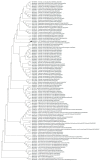Molecular Diagnosis of Cetacean Morbillivirus in Beaked Whales Stranded in the Canary Islands (1999-2017)
- PMID: 35324849
- PMCID: PMC8950905
- DOI: 10.3390/vetsci9030121
Molecular Diagnosis of Cetacean Morbillivirus in Beaked Whales Stranded in the Canary Islands (1999-2017)
Abstract
A retrospective survey for detecting the cetacean morbillivirus (CeMV) was carried out in beaked whales (BWs) stranded in the Canary Islands (1999-2017). CeMV is responsible for causing worldwide epizootic events with the highest mass die-offs in cetaceans, although the epidemic status of the Canarian Archipelago seems to be that of an endemic situation. A total of 319 tissue samples from 55 BWs (35 Cuvier's BWs and 20 specimens belonging to the Mesoplodon genus) were subjected to the amplification of a fragment of the fusion protein (F) and/or phosphoprotein (P) genes of CeMV by means of one or more of three polymerase chain reactions (PCR). RNA integrity could not be demonstrated in samples from 11 animals. Positivity (dolphin morbillivirus strain (DMV)) was detected in the skin sample of only a subadult male Cuvier's BW stranded in 2002, being the earliest confirmed occurrence of DMV in the Cuvier's BW species. The obtained P gene sequence showed the closest relationship with other DMVs detected in a striped dolphin stranded in the Canary Islands in the same year. A phylogenetic analysis supports a previous hypothesis of a cross-species infection and the existence of the circulation of endemic DMV strains in the Atlantic Ocean similar to those later detected in the North-East Atlantic, the Mediterranean Sea and the South-West Pacific.
Keywords: Canary Islands; PCR; Ziphiidae; Ziphius cavirostris; beaked whales; cetaceans; morbillivirus.
Conflict of interest statement
The authors declare no conflict of interest.
Figures




Similar articles
-
Dolphin Morbillivirus in a Cuvier's Beaked Whale (Ziphius cavirostris), Italy.Front Microbiol. 2017 Jan 31;8:111. doi: 10.3389/fmicb.2017.00111. eCollection 2017. Front Microbiol. 2017. PMID: 28197145 Free PMC article.
-
Contribution to Herpesvirus Surveillance in Beaked Whales Stranded in the Canary Islands.Animals (Basel). 2021 Jun 28;11(7):1923. doi: 10.3390/ani11071923. Animals (Basel). 2021. PMID: 34203458 Free PMC article.
-
Morbillivirus infection in Risso's dolphin Grampus griseus: a phylogenetic and pathological study of cases from the Canary Islands.Dis Aquat Organ. 2018 Aug 14;129(3):165-174. doi: 10.3354/dao03248. Dis Aquat Organ. 2018. PMID: 30154276
-
Plastic ingestion by two cetacean groups: Ziphiidae and Delphinidae.Environ Pollut. 2023 Sep 15;333:121932. doi: 10.1016/j.envpol.2023.121932. Epub 2023 Jun 17. Environ Pollut. 2023. PMID: 37336348 Review.
-
Advances in research on the impacts of anti-submarine sonar on beaked whales.Proc Biol Sci. 2019 Jan 30;286(1895):20182533. doi: 10.1098/rspb.2018.2533. Proc Biol Sci. 2019. PMID: 30963955 Free PMC article. Review.
Cited by
-
Pyogranulomatous dermatitis with Enterococcus faecalis in a spotted seal (Phoca larga).Vet Med Sci. 2023 Mar;9(2):985-991. doi: 10.1002/vms3.973. Epub 2022 Oct 17. Vet Med Sci. 2023. PMID: 36253881 Free PMC article.
-
Epidemiology of Wildlife Infectious Diseases.Vet Sci. 2023 May 5;10(5):332. doi: 10.3390/vetsci10050332. Vet Sci. 2023. PMID: 37235415 Free PMC article.
-
A systematic review on global zoonotic virus-associated mortality events in marine mammals.One Health. 2024 Aug 4;19:100872. doi: 10.1016/j.onehlt.2024.100872. eCollection 2024 Dec. One Health. 2024. PMID: 39206255 Free PMC article. Review.
-
Epidemiological and genetic analysis of Cetacean Morbillivirus circulating on the Italian coast between 2018 and 2021.Front Vet Sci. 2023 Jul 31;10:1216838. doi: 10.3389/fvets.2023.1216838. eCollection 2023. Front Vet Sci. 2023. PMID: 37583469 Free PMC article.
-
Morbillivirus and coronavirus survey in stranded cetaceans, Brazil.PLoS One. 2025 Mar 10;20(3):e0316050. doi: 10.1371/journal.pone.0316050. eCollection 2025. PLoS One. 2025. PMID: 40063531 Free PMC article.
References
Grants and funding
LinkOut - more resources
Full Text Sources

